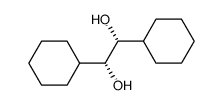(S,S)-(-)-2,3-DIHYDROXY-N,N,N,N-TETRAMETHYLSUCCINAMIDE
Modify Date: 2025-08-27 00:28:59

(S,S)-(-)-2,3-DIHYDROXY-N,N,N,N-TETRAMETHYLSUCCINAMIDE structure
|
Common Name | (S,S)-(-)-2,3-DIHYDROXY-N,N,N,N-TETRAMETHYLSUCCINAMIDE | ||
|---|---|---|---|---|
| CAS Number | 120850-91-1 | Molecular Weight | 226.35500 | |
| Density | 1.193g/cm3 | Boiling Point | 373ºC at 760mmHg | |
| Molecular Formula | C14H26O2 | Melting Point | 136-141ºC | |
| MSDS | N/A | Flash Point | 179.8ºC | |
| Name | (s,s)-(+)-1,2-dicyclohexyl-1,2-ethanediol |
|---|---|
| Synonym | More Synonyms |
| Density | 1.193g/cm3 |
|---|---|
| Boiling Point | 373ºC at 760mmHg |
| Melting Point | 136-141ºC |
| Molecular Formula | C14H26O2 |
| Molecular Weight | 226.35500 |
| Flash Point | 179.8ºC |
| Exact Mass | 226.19300 |
| PSA | 40.46000 |
| LogP | 2.86880 |
Synonym:None Known Section 2 - COMPOSITION, INFORMATION ON INGREDIENTS
Risk Phrases: None Listed. Section 3 - HAZARDS IDENTIFICATION EMERGENCY OVERVIEW
The toxicological properties of this material have not been fully investigated. Potential Health Effects Eye: May cause eye irritation. Skin: May cause skin irritation. Ingestion: May cause irritation of the digestive tract. The toxicological properties of this substance have not been fully investigated. Inhalation: May cause respiratory tract irritation. The toxicological properties of this substance have not been fully investigated. Chronic: No information found. Section 4 - FIRST AID MEASURES Eyes: In case of contact, immediately flush eyes with plenty of water for at least 15 minutes. Get medical aid. Skin: In case of contact, flush skin with plenty of water. Remove contaminated clothing and shoes. Get medical aid if irritation develops and persists. Wash clothing before reuse. Ingestion: If swallowed, do not induce vomiting unless directed to do so by medical personnel. Never give anything by mouth to an unconscious person. Get medical aid. Inhalation: If inhaled, remove to fresh air. If not breathing, give artificial respiration. If breathing is difficult, give oxygen. Get medical aid. Notes to Physician: Treat symptomatically and supportively. Section 5 - FIRE FIGHTING MEASURES General Information: As in any fire, wear a self-contained breathing apparatus in pressure-demand, MSHA/NIOSH (approved or equivalent), and full protective gear. During a fire, irritating and highly toxic gases may be generated by thermal decomposition or combustion. Extinguishing Media: Use water spray, dry chemical, carbon dioxide, or appropriate foam. Section 6 - ACCIDENTAL RELEASE MEASURES General Information: Use proper personal protective equipment as indicated in Section 8. Spills/Leaks: Clean up spills immediately, observing precautions in the Protective Equipment section. Sweep up or absorb material, then place into a suitable clean, dry, closed container for disposal. Avoid generating dusty conditions. Provide ventilation. Section 7 - HANDLING and STORAGE Handling: Wash thoroughly after handling. Use with adequate ventilation. Minimize dust generation and accumulation. Avoid contact with eyes, skin, and clothing. Keep container tightly closed. Avoid ingestion and inhalation. Storage: Store in a tightly closed container. Store in a cool, dry, well-ventilated area away from incompatible substances. Section 8 - EXPOSURE CONTROLS, PERSONAL PROTECTION Engineering Controls: Facilities storing or utilizing this material should be equipped with an eyewash facility and a safety shower. Use adequate ventilation to keep airborne concentrations low. Exposure Limits CAS# 120850-91-1: Personal Protective Equipment Eyes: Wear appropriate protective eyeglasses or chemical safety goggles as described by OSHA's eye and face protection regulations in 29 CFR 1910.133 or European Standard EN166. Skin: Wear appropriate protective gloves to prevent skin exposure. Clothing: Wear appropriate protective clothing to prevent skin exposure. Respirators: A respiratory protection program that meets OSHA's 29 CFR 1910.134 and ANSI Z88.2 requirements or European Standard EN 149 must be followed whenever workplace conditions warrant respirator use. Section 9 - PHYSICAL AND CHEMICAL PROPERTIES Physical State: Crystalline powder Color: white Odor: Not available. pH: Not available. Vapor Pressure: Not available. Viscosity: Not available. Boiling Point: Not available. Freezing/Melting Point: 136 - 141 deg C Autoignition Temperature: Not available. Flash Point: Not available. Explosion Limits, lower: Not available. Explosion Limits, upper: Not available. Decomposition Temperature: Solubility in water: Specific Gravity/Density: Molecular Formula: C14H26O2 Molecular Weight: 226.1808 Section 10 - STABILITY AND REACTIVITY Chemical Stability: Not currently available. Conditions to Avoid: Dust generation. Incompatibilities with Other Materials: Strong oxidizing agents. Hazardous Decomposition Products: Carbon monoxide, carbon dioxide. Hazardous Polymerization: Has not been reported Section 11 - TOXICOLOGICAL INFORMATION RTECS#: CAS# 120850-91-1 unlisted. LD50/LC50: Not available. Carcinogenicity: (S,S)-(+)-1,2-Dicyclohexyl-1,2-ethanediol - Not listed by ACGIH, IARC, or NTP. Section 12 - ECOLOGICAL INFORMATION Section 13 - DISPOSAL CONSIDERATIONS Dispose of in a manner consistent with federal, state, and local regulations. Section 14 - TRANSPORT INFORMATION IATA Shipping Name: Not regulated. Hazard Class: UN Number: Packing Group: IMO Shipping Name: Not regulated. Hazard Class: UN Number: Packing Group: RID/ADR Shipping Name: Not regulated. Hazard Class: UN Number: Packing group: Section 15 - REGULATORY INFORMATION European/International Regulations European Labeling in Accordance with EC Directives Hazard Symbols: Not available. Risk Phrases: Safety Phrases: S 24/25 Avoid contact with skin and eyes. WGK (Water Danger/Protection) CAS# 120850-91-1: No information available. Canada None of the chemicals in this product are listed on the DSL/NDSL list. CAS# 120850-91-1 is not listed on Canada's Ingredient Disclosure List. US FEDERAL TSCA CAS# 120850-91-1 is not listed on the TSCA inventory. It is for research and development use only. SECTION 16 - ADDITIONAL INFORMATION N/A |
| Safety Phrases | S24/25 |
|---|
| Precursor 0 | |
|---|---|
| DownStream 1 | |
| (S,S)-1,2-dicyclohexylethane-1,2-diol |
| (-)-1,2-dicyclohexyl-1,2-ethanediol |
| (R,R)-1,2-dicyclohexylethane-1,2-diol |
| (S,S)-1,2-dicyclohexyl-1,2-ethanediol |
| (1S,2S)-1,2-dicyclohexylethane-1,2-diol |
| (1S,2S)-1,2-dicyclohexyl-1,2-ethanediol |
 CAS#:120850-92-2
CAS#:120850-92-2